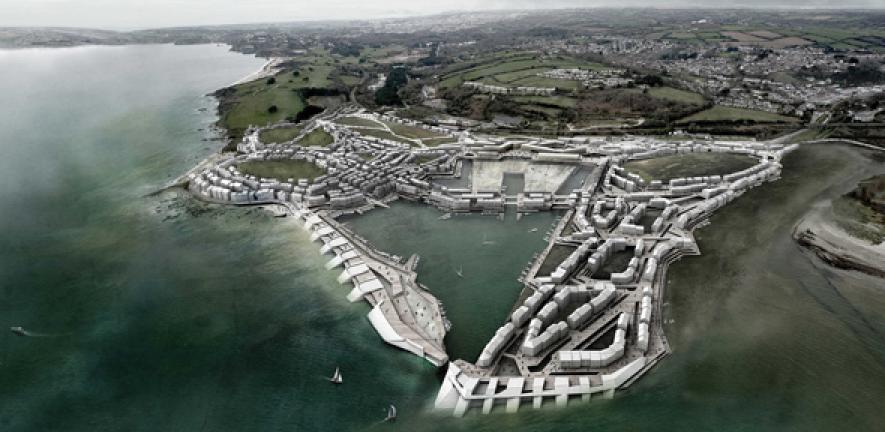
The sea sustains life but also threatens it. An innovative design concept by Ed Barsley aims to contend with rising seawater by welcoming it into our coastal settlements.
The sea sustains life but also threatens it. An innovative design concept by Ed Barsley aims to contend with rising seawater by welcoming it into our coastal settlements.
We have to change our attitudes towards possession and risk, and stop fighting a losing battle with nature
Ed Barsley
Flooding from rising sea levels and extreme weather events is a major global issue, and the UK is no exception. According to the Government’s 2012 Climate Change Impact Risk Assessment, flooding is the greatest threat facing the UK today.
The UK’s current strategy for coastal defence is largely reliant on rigid structures such as sea walls. Many of these are reaching the end of their design life, and proving disadvantageous in terms of cost, restrictive access to the sea and limited capacity to adapt to rising sea levels.
As for the longer term, the Future Foresight flood research project commissioned by government and published in 2004, concluded that the government’s 100-year shoreline defence plans were not adaptive enough to cope with changes expected within the next 15 to 30 years.
But how can walls and buildings – which we take for granted as solid, enduring structures – adapt to a landscape that is gradually changing from firm ground to wetlands to sea? Does such an adaption require a sea-change in our own attitudes to permanence in our built environment?
Ed Barsley, who completed a Master’s in Architecture and Urban Design last year in the University of Cambridge's Department of Architecture and has now started a PhD, believes it does, and has come up with an adaptive, flexible approach to coastal flooding as innovative in design and technological terms as it is sensitive in cultural ones.
“I aimed to design a town that is intrinsically able to inhabit this increasingly flood-prone landscape,” he said. “It is characterised by two distinctive features. The first is a multi-layered threshold that combines soft and hard defences. The second is that every one of these thresholds is permeable by the sea.”
Barsley based his study in the town of Par near St Austell, inspired by a year spent building and designing eco-houses in Cornwall. Shortlisted for the Government’s now defunct Eco-town scheme, Par has been earmarked as a future key commercial and transport hub for the region. Yet it is at high risk of flooding.
Barsley’s concept starts not in the town itself, but out at sea. Wave attenuation devices would divert the waves’ energy, and harness it to power the town. A zone of coastal nourishment, created by spraying sediment on the sea bed, would then graduate the force of the waves and help dissipate their power. Next, a series of interconnected saline lagoons would help to further reduce the waves’ crest height and velocity, as well as provide vital wildlife habitats.
It would only be at the harbour that the sea meets a wall – and one with a difference. “My sea wall, which also acts as a social causeway, is perforated, its apertures work to diffuse the flow of the waves before they enter the harbour,” said Barsley. ”It has been designed to provide access to the water’s edge at a variety of height levels depending on the tides. Like the Thames Barrier, it could lock down and close up during extreme weather conditions.”
The town itself is designed on the same principle as the permeable sea wall. “Buildings designed to act as buffers are juxtaposed with ones designed to let the water through, so as to enable the people of Par to maintain use of some buildings during a flood event” said Barsley. “Furthermore, because the apertures of the porous buildings are smaller at the front than at the back, the varied configuration of buildings would mean that the streets themselves act like the sea wall, further attenuating the turbidity of the water.”
Par is situated on ground that slopes up from the sea. The planning of Barsley’s town takes advantage of this. Organised on the basis of phased inhabitation zones, a range of street levels provides shelter and access routes, with essential services on highest ground.
This results in a main high street that is not only a refuge but is quintessentially Cornish in style and atmosphere. It is peppered with lateral access routes – narrow twisting lanes, winding staircases and inclines – that lead down to the harbour and afford tantalising glimpses of the sea. This charming, higgledy-piggledy style (or ‘Cornish vernacular’ as it known to architects) has emerged from Barsley’s strategic response to the need for resilience, rather than being a pastiche.
Despite its resilience, large portions of Barsley’s town would, eventually, become submerged: current data from the Intergovernmental Panel on Climate Change predicts that Par will be flooded on a daily basis by 2100. Barsley’s design caters for a future beyond this point. “Once submerged,” he said, “the town as a whole would form a major water-calming device in the same way as the other permeable thresholds, by both obstructing and attenuating the waves. As wetlands form in the area behind the town, the water would, I hope, be sufficiently calm to accommodate floating homes and amphibious technologies proven in their efficacy on still water, but unsuited to choppy sea-water.”
The fundamental principle behind Barsley’s design for Par is that it should enable its residents to live in harmony with the ebb and flow of the sea. To an extent, they already go with the flow: the tides in Par fluctuate by 4.5 metres on an average day.
As well as adapting to the tides in pragmatic terms, however, Barsley believes that a fundamental shift in cultural attitudes towards the idea of possession of property is needed, because gradually, but inexorably, the sea is re-possessing the land. So Barsley’s design is based on the assumption of a policy of 50-year leasehold land parcels to underpin the strategy of Phased Inhabitation Zones. “A ground floor unit by the waterfront might start off life as a café or an artist’s studio,” he explained, “but after 50 years might need, for instance, to turn into a boatshed or a store. And at some point that unit will have to be abandoned and left to function as a defence threshold. We have to change our attitudes towards possession and risk, and stop fighting a losing battle with nature.”
Barsley begins his thesis with H G Wells’ prescient warning written in 1945: ‘Adapt or perish, now as ever, is nature’s inexorable imperative’. Barsley, and his fellow students and graduates of the Department of Architecture at Cambridge, are responding to the challenge.
Koen Steemers, Professor of Sustainable Design and Head of the Department of Architecture, said: “Ed’s project exemplifies design research that builds on the latest multidisciplinary research expertise to synthesise and test an imaginative design in response to pressing environmental issues. Because of the real potential application of such projects, recognised by the architectural profession, developers and policy-makers worldwide, we are now looking into setting up an enterprise advisory scheme to help realise such innovative and necessary visions of architecture.”
You can find more information about the pioneering work of students in Architecture and Urban Design including details of Ed Barsley’s project.
This work is licensed under a Creative Commons Licence. If you use this content on your site please link back to this page.





